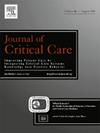ICU中亚综合征性谵妄转变和结局的危险因素:一项前瞻性多中心队列研究的事后分析
IF 2.9
3区 医学
Q2 CRITICAL CARE MEDICINE
引用次数: 0
摘要
目的确定危重成人患者发展为谵妄的危险因素和亚综合征性谵妄(SSD)的结局。方法采用重症监护谵妄筛查清单(ICDSC)对患者进行多中心前瞻性研究,排除原发性神经系统诊断或持续性昏迷的患者。SSD被定义为ICDSC得分为1-3。主要结局是SSD进展的危险因素及其与医院死亡率的关系。次要结局包括ICU死亡率和住院时间。结果1572例患者中,562例(35.8%)无谵妄,488例(31%)SSD无谵妄,180例(11.5%)SSD进展为谵妄,174例(11.1%)谵妄无SSD病史。168例(10.7%)谵妄状态不明。SSD发病的危险因素为女性、较高的APACHE IV评分和住院/急诊手术。SSD进展危险因素包括较高的APACHE IV评分、医疗/急诊手术入院、代谢性酸中毒和前24小时吗啡剂量。SSD患者的住院死亡率低于谵妄患者(OR 0.57, 95% CI 0.36至0.90),但与非谵妄患者相比无显著差异(OR 1.30, 95% CI 0.69至2.42)。SSD患者的ICU住院时间比谵妄患者短,但比非谵妄患者长。结论:本研究确定了风险概况,并证实SSD是一种中间预后状况,支持早期干预以预防谵妄相关危害。试验注册:ClinicalTrials.gov标识符NCT01952899(2013年9月30日注册)。本文章由计算机程序翻译,如有差异,请以英文原文为准。
Risk factors for transitions and outcomes of subsyndromal delirium in the ICU: Post-hoc analysis of a prospective multicenter cohort study
Purpose
Identify risk factors for progression to delirium and outcomes of subsyndromal delirium (SSD) in critically ill adults.
Methods
Multicenter prospective study screening patients with the Intensive Care Delirium Screening Checklist (ICDSC), excluding those with primary neurologic diagnosis or persistent coma. SSD was defined as an ICDSC score 1–3. Main outcomes were risk factors for SSD progression and association with hospital mortality. Secondary outcomes included ICU mortality and length of stay.
Results
Among 1572 patients, 562 (35.8 %) had no delirium, 488 (31 %) SSD without delirium, 180 (11.5 %) SSD progressing to delirium and 174 (11.1 %) delirium without prior SSD. For 168 (10.7 %) delirium status was unknown. SSD onset risk factors were female sex, higher APACHE IV score, and medical /emergency surgery admissions. SSD progression risk factors included higher APACHE IV score, medical/emergency surgery admissions, metabolic acidosis and morphine dosage in the first 24 h. SSD patients had lower hospital mortality than delirium patients (OR 0.57, 95 %CI 0.36 to 0.90), but no significant difference compared to non-delirious patients (OR 1.30, 95 %CI 0.69 to 2.42). SSD patients had shorter ICU stays than delirium patients but longer than non-delirious patients.
Conclusions
This study identified risk profiles and validated SSD as an intermediate prognostic condition, supporting early interventions to prevent delirium-associated harms.
Trial registration: ClinicalTrials.gov Identifier NCT01952899 (registered September 30, 2013).
求助全文
通过发布文献求助,成功后即可免费获取论文全文。
去求助
来源期刊

Journal of critical care
医学-危重病医学
CiteScore
8.60
自引率
2.70%
发文量
237
审稿时长
23 days
期刊介绍:
The Journal of Critical Care, the official publication of the World Federation of Societies of Intensive and Critical Care Medicine (WFSICCM), is a leading international, peer-reviewed journal providing original research, review articles, tutorials, and invited articles for physicians and allied health professionals involved in treating the critically ill. The Journal aims to improve patient care by furthering understanding of health systems research and its integration into clinical practice.
The Journal will include articles which discuss:
All aspects of health services research in critical care
System based practice in anesthesiology, perioperative and critical care medicine
The interface between anesthesiology, critical care medicine and pain
Integrating intraoperative management in preparation for postoperative critical care management and recovery
Optimizing patient management, i.e., exploring the interface between evidence-based principles or clinical insight into management and care of complex patients
The team approach in the OR and ICU
System-based research
Medical ethics
Technology in medicine
Seminars discussing current, state of the art, and sometimes controversial topics in anesthesiology, critical care medicine, and professional education
Residency Education.
 求助内容:
求助内容: 应助结果提醒方式:
应助结果提醒方式:


